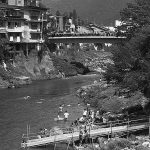With sumo Yokozuna (Grand Champion) Asashoryu getting ready for his third tournament since serving his two-tournament suspension, all eyes are on him to see if he can return to top form following his failure to win the Hatsu basho (tournament) in January. While his record in the Haru basho was much improved/disappointing/more of the same, the question remains as to whether he can return to the once-dominant wrestler that has amassed a career record of 21 tournament victories in the top-level Makuuchi division.
The Mongolian-born wrestler came to Japan as an exchange student and made his professional sumo debut in 1999. While other Mongolian wrestlers Kyokushuzan and Kyokutenho were already wrestling in Japan and highly regarded stars in their home country, Asashoryu was quick to steal their limelight as his achievements quickly overshadowed theirs. Within two years Asashoryu reached the top Makuuchi division, winning the first of his three Outstanding Performance awards in May 2001. After only 12 tournaments in the top division, and 24 total, Asashoryu landed his first victory with an impressive 14-1 record in the Kyushu basho, only to follow that victory with another 14-1 record in the Hatsu basho of 2003. While not guaranteed, two victories in a row is the de facto minimum required to allow a wrestler to be promoted to Yokozuna and in January of 2003, Asashoryu became the sports 68th Grand Champion and only the 3rd foreign-born wrestler to do so.
From early on in his career, Asashoryu was considered to be one of the best prospects in sumo and after his promotion to Yokozuna, he worked hard at cementing his reputation as one of the most successful wrestlers ever. In the first two tournaments of 2004, Asashoryu achieved back-to-back wins with perfect 15-0 records in both of these tournaments and has since added three more perfect tournaments to give him five so-called zensho yusho victories. In 2004, Asashoryu became the first wrestler to win 5 tournaments in a year since the feat was achieved by the great Chiyonofuji in 1986 and earned his 9th Emperors Cup with his 9th victory. 2005 saw him continue his winning ways, capturing the cup in all six tournaments of the year and, combined with his final win in 2004, gave him seven wins in a row, something which no wrestler had done before or since. He remained dominant throughout 2006 winning four out of six, failing to win one and sitting out most of another due to injury.
Asashoryu has gained a reputation as one with little regard for sumo decorum due to a hair pulling incident during a match and dressing room fights with other wrestlers. He is also known to practice with what could be characterized as too much “fighting spirit” as several wrestlers have been injured while sparring with him. Along these controversial lines, the watershed year for Asashoryu would be 2007, where, after winning the Hatsu basho in January and the Nagoya basho in July, he returned to Mongolia to rehabilitate injuries to his elbow and lower back. In doing so, he skipped the annual regional goodwill tournaments held by the Sumo Association in areas where the major tournaments are not played, in this case Tohoku and Hokkaido. Unlike North American All-Star contests, where participation by top players is not guaranteed, the Sumo Association places a great deal of importance on these matches, expecting all wrestlers to participate, as they are used as public relations venues to promote the sport, reward fans and work with children. Asashoryu created uproar with the sumo association, the Japanese media and the public when he was seen on TV not rehabilitating his injuries, but participating in a charity soccer match with Japanese soccer star Hidetoshi Nakata.
Asashoryu was immediately taken to task by the Sumo Association who demanded that he return to Tokyo to explain his actions, adding that regardless of his medical condition, he would not be welcome on the goodwill tour, depriving his many fans of a wrestler still
considered one of the top wrestlers of all time. Unfortunately for him, 2007 saw another first by the bad-boy from Mongolia as he became the only Yokozuna in the sport’s 2,000-year history to be suspended from participating in a tournament, receiving a two basho suspension as well as a 30% pay cut over the course of his suspension.
While some point to Asashoryu as proof positive that a foreign wrestler can achieve success in this extremely homogenous sport, others have a different view. Asashoryu’s failure to return to top form and regain favor in the eyes of the Sumo Association will further bolster sumo purist’s arguments that foreigners lack the personal and mental attributes necessary to hold the sports loftiest position.
Regardless, if he is able to return to top form, he will almost certainly continue to provide some of the most exciting sumo that fans could hope for.
Story by James Souilliere
From J SELECT Magazine, May 2008















Recent Comments